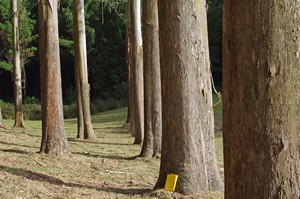Exciting new possibilities for eucalypts
 Eucalypts are a promising commercial plantation species. With their strength, hardness and attractive appearance, and in some species, durability, they provide timber for a range of markets from furniture and outdoor uses, to fibre for high quality papers.
Eucalypts are a promising commercial plantation species. With their strength, hardness and attractive appearance, and in some species, durability, they provide timber for a range of markets from furniture and outdoor uses, to fibre for high quality papers.
However the popularity of growing eucalypts fluctuates. At present, the estimated 25,000 hectares of eucalypt forests in New Zealand comprises only about 1.4% of the commercial forest estate, yet New Zealand imports about $30 million of hardwood each year and even more in wooden furniture. The opportunity exists to expand the market for locally grown eucalypts as a sustainable alternative to these imported hardwoods.
Scion has been breeding and researching eucalypts for over 40 years, focusing mainly on the three species grown as short rotation fibre crops - Eucalyptus fastigata, E. regnans and E. nitens.
“Interest in growing eucalypts is cyclical depending on the price paid for wood chips here and internationally,” says Scion tree breeder Toby Stovold. “It’s therefore important to keep the breeding programme moving so there is a ready supply of good quality seed available for all three species. Our focus is on improving volume and the gains made each generation make the crop more profitable each time we deploy new seed.”
Scion is also bringing in new technologies to help the breeding programme. “We DNA fingerprint all the new E. nitens selections to help limit inbreeding,” says molecular breeding scientist Dr Emily Telfer. “This allows us to identify the seed parents, and limit their representation in the next generation. It also means we can continue to use open pollination strategies rather than costly, time-consuming controlled pollination.
“We have plans to further develop other eucalypt species for solid wood production, specifically the naturally durable E. muelleriana and E. pilularis, and produce improved seed based on existing provenance progeny trials. The aim is to complement the New Zealand Drylands Forest Initiative (NZDFI) programme. Selections from the E. muelleriana trials have already been incorporated into the NZDFI trials. E. pilularis is not a dryland species and its potential clearly lies in the warmer, wetter areas of the country such as Northland”.
The key to growing eucalypts is matching the right species to the right site, and there are currently around 250 eucalypt species planted in New Zealand to choose from. Scion’s breeding trials, permanent sample plots and models are all helping to increase the extent of commercially grown eucalypts for different purposes. These trials provide information about the adaptation of different eucalypt species to specific site types.
Eucalyptus fastigata is often referred to as the ‘radiata’ of eucalypts. It tolerates a wide range of sites and produces high volumes per hectare. Breeding trials are currently in the second and third generation resulting in greatly reduced forking and improved growth and form. Scion is working with forest tree seed company Proseed to build the supply of seed from improved third generation material.
Eucalyptus regnans is the world’s tallest hardwood tree, able to grow at a rate of up to three metres per year. It was widely planted in New Zealand until the 1990s but planting was reduced due to tree health issues. Breeding for growth, form and health has continued however, using a simple single-population and selection based on disease tolerance. The breeding programme is currently entering its fourth generation. Most of these trees are more resistant to leader dieback and fungal health problems that plagued them earlier. Current stands are looking to set growth records with average heights of six metres in 30 months and the best trees at over nine metres. Seed will be available in 2016.
Eucalyptus nitens is the most advanced in breeding terms. Previous selection work for this species has resulted in trees well suited for New Zealand conditions as an appearance grade timber. Third generation trials have shown good results for diameter, volume, form and density with seed likely to be available in two years. E. nitens is prone to attack from the defoliating Paropsis charybdis (eucalypt tortoise beetle) however on-going research into biocontrol holds promise, particularly using a Tasmanian parasitoid wasp, Eadya paropsidis. A screening trial has been established that will help future deployment of material less likely to be attacked.
Next steps
Scion is working with the forestry industry to develop an exciting new partnership for growing and processing eucalypts. The initiative includes these species with the aim of creating new value chains at a regional scale. The proposal will investigate how to increase certainty of growing the right species on the right site, in what region and ultimately producing maps for growers and processors alike. In addition, we intend to identify what new products can be made that match with market requirements, while extracting more product of higher value from each tree. This initiative is expected to be running by Christmas 2014. Enquires are welcome.For further information: Contact Dr Heidi Dungey at Show email
